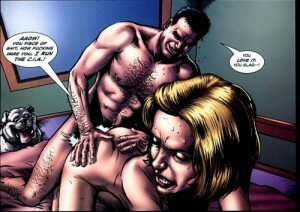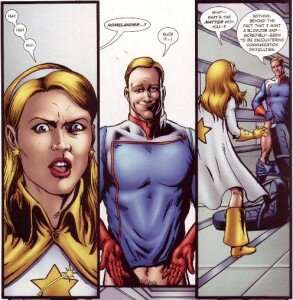Sex and Superheroes in “The Boys” (NSFW)
The latest opus from Garth Ennis (author of Preacher, Hellblazer, The Punisher) is a brutal satire entitled The Boys. It charts the exploits of a group of thugs clandestinely employed by the CIA. Their task is to control, by any means necessary, various teams of high profile superheroes, whose carelessness, stupidity, arrogance and selfishness cause far more damage to society than the antics of the supervillains they oppose. Controversially, the comic mixes harsh brutality with its uncompromising anti-superhero polemic, with graphically violent illustrations from DC illustrator, Darick Robertson. Famously, Ennis declared that he intended to ‘out-Preacher Preacher’ with this project, and he sets about it with gusto. By the end of the first arc there have been scenes of brutal murder, sex orgies and even an instance of a hamster taped up someone’s anus. In short, The Boys is definitely not for kids.
Sexually, the comic tries to go beyond the pale in the name of liberalism, with mixed results. This isn’t to say that The Boys is illiberal, misogynist or homophobic – its willingness to bring the issue of taboo sex into the open on repeated occasions in the context of a superhero comic shows an acute awareness that there are serious ideological questions about the nature of sexuality, exploitation and queerness that still desperately need to be raised in regard to mainstream comic fare. However, as it tries to live up to its marketing promise of “out-preachering Preacher”, seeking to sell through its sensational luridness, The Boys comes remarkably close at times to emulating all that it supposedly abhors. The gambit seems to be that readers will not object, lest they appear old fashioned and prudish. In this discussion I’d like to examine some of the ways in which Ennis is successful at addressing issues of sex and gender, and some of the areas where he falls woefully short; suggesting that whilst The Boys is often intellectually successful, there is a tension between its intelligence and the way it is marketed as a lurid exploitation piece for commercial success.
Perhaps the strongest moment in the first three arcs of the series to date (issues 1-14)is the induction of Annie January, aka Starlight. A former member of a clean cut, goody-two-shoes superhero team, she is inducted into “The Seven”, Ennis’s version of The Justice League, headed by the Superman-like “Homelander”. At first, she is thrilled to be a part of the most prestigious superhero group, but her illusions are shattered when she is given a shocking ultimatum by Homelander: she can be a member of the team only if she gives its male members, Homelander, Black Noir and A-Train, a blowjob. 1) The superheroes make it clear that they aren’t forcing themselves on Annie, merely that she has to realize that there are ways and means of getting on in the world. Ennis is quick to bring out real world parallels: when Annie asks,disbelievingly, “You mean I have to have sex with you to join the team?” Homelander responds “Well, Bill Clinton might argue the definition with you. But yes”.
Starlight’s story is set to progress over the full 60 issue run and is clearly one of the centrepieces of the comic. Having been sexually abused, she is subsequently humiliated publicly, the story of her degradation told across many superhero board meetings, at which The Seven also discuss issues of marketability and merchandising (2), and argue about their cuts from sales of trademarked material. When Starlight offers up her own ideas, which include encouraging and praying for another superhero group facing difficulties, she is ignored by Homelander who cuts across her to state that she has just reminded him of another lucrative source of advertising revenue. He proceeds to draw a huge V across her chest stating that a costume along these more revealing lines will make for better photo opportunities. (3)
It is in these first six issues, published by Wildstorm (an imprint of DC) that the satire of the comic is at its most brutal, funny and potent. The characters under attack are all too obviously DC creations (Superman, The Flash, Batman, Wonder Woman, Aquaman). With hindsight, the swift cancellation of the comic by DC seems somewhat inevitable: given the company’s reputation for protecting its image and characters, a comic that portrayed them as misogynistic sexual abusers was unlikely to be well received internally. However, the comic had already gained enough notoriety to be picked up by Dynamite Entertainment, a much smaller imprint in the independent comics market. Unfortunately, it seems that either Dynamite or Ennis decided at this point that the fans were returning not for the satire and wit, but for the comic’s in-your-face sexuality, violence and luridly weird concepts. Consequently, the earlier, more feminist viewpoint vanished, to be replaced by an obnoxious, antithetical worldview.
Some fans might argue that there is an element of continuity here. In The Boys issues 1-6, misogyny is well represented. The leader of the Boys, The Butcher, has frequent sexual encounters with Susan Rayner, head of the CIA and uber-boss of the group, despite the fact that she supposedly despises him. Their sex sessions are full of pornographic cliché: she is submissive, fucked from behind by a man who constantly tells her how much of a slut she is. However, while the comic’s readers are often led to endorse the viewpoint of The Boys and their anti-superhero stance, they are by no means supposed to agree with all of their actions. The main narrative filter is Wee Hughie, a young man inducted into The Boys after his girlfriend is carelessly killed in an instance of superhero neglect, and who constantly questions the group’s methods. Read in this light, The Butcher’s casual misogynism can be seen as one of Ennis’s tactics to imply that The Boys are no better than the superheroes they control.

You Love it, You Slag!
However, the second story arc, entitled “Get Some” (4), loses this ambivalence and heads straight in the direction of puerile juvenile fantasy. It begins with the story of The Tek Knight, a man inflicted with a disease which means that he is compelled to have sex with anything in sight, be it man, woman or inanimate object. The arc then moves on to detail the events surrounding the murder of a gay man by Swingwing, a staunchly homophobic superhero who has tried to appear gay to gain media attention. The allusions to popular conceptions of Batman and Robin as a gay couple are heavy handed and unsubtle, working not as satire on comic book mythology but as a childish extended gay joke for playground consumption. The situation is made still worse when Hughie chides The Butcher’s insistence for using words like “poof” and “bumchums”, setting up one of Ennis’s childish, ill-considered and self-congratulatory rants against political correctness. Hughie learns that he is himself homophobic, since he is afraid to enter a gay bar, and is given a lecture by “The Frenchman” (another of The Boys) about homophobia being ‘just words’
The third story arc, “Glorious Five-Year Plan”, is scarcely better, with sex still used as a means to make cheap jokes, the implications of which Ennis doesn’t appear to have thought through. ‘Little Nina’, the head of the Russian mafia, is shown getting her kicks from a vibrator on an aeroplane, only to discover that the sex toy contains a bomb, which detonates. As a joke it’s not enough to raise a smile but the crass stereotyping, and ultimate destruction of strong, sexual women, verges on the offensive.
Offending people has clearly been Ennis’s marketing strategy from the get-go with The Boys. However, offensiveness can take many forms. The difference between biting satire and a garbage heap is that the former delivers shock and sensationalism in a way that’s thought-provoking and reasonably coherent, whereas the latter stands as a stinking heap of ill-assorted junk. Ennis needs to stop vacillating, and decide whether he wants to inhabit a space that is feminist or misogynist, politically aware or childishly puerile. Ultimately, the early issues of the boys, with their well structured, close to the bone, satirical storylines are far more shocking than the rather wearisome later issues, which try so hard to scandalize that they simply end up boring the reader.
1 Issue 3. Black Noir is thought the represent Batman, The A-Train is The Flash
2 Issue 4
3 Issue 5
4 Issues 7-10









Garth Ennis tends to be an oddity as a writer because he is capable of being contradicting with his work. On one hand he often writes nihilistic and overtly pessimistic work that borders on the obscene and is said to make you doubt in the basic decency of fellow humans. But he is capable of writing some greater character moments such as Wee Hughie being the only character in the Boys who is a true hero and Jesse Custer from Preacher being a old school western hero.
Not sure I agree with the assessment that “Get Some” is juvinile. It’s signiture problem is that it works better on a second reading than on a first. The detective nature of the plot with parallels what could arseholeishly be described as the (eww) Meta-detective nature of the reading experience (I feel sick just writing that). The Reader is asked to solve Tek-Knights rampant sexuallity using the clues within the narative, all the clues are there and characters are frequently asked to look beyond simple stereotypes but at the sametime, no-one ever thinks to ask what makes a person the way they are.
Honestly, I think “Get Some” is one of the cleverest bits of fiction I’ve read in a while.
Leave your response!
Departments
Browse by Issue